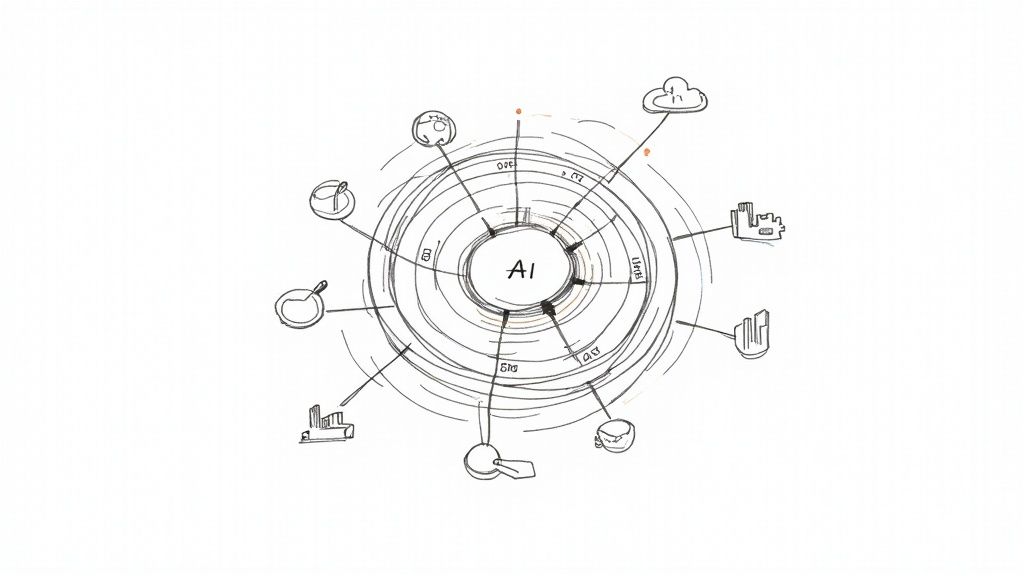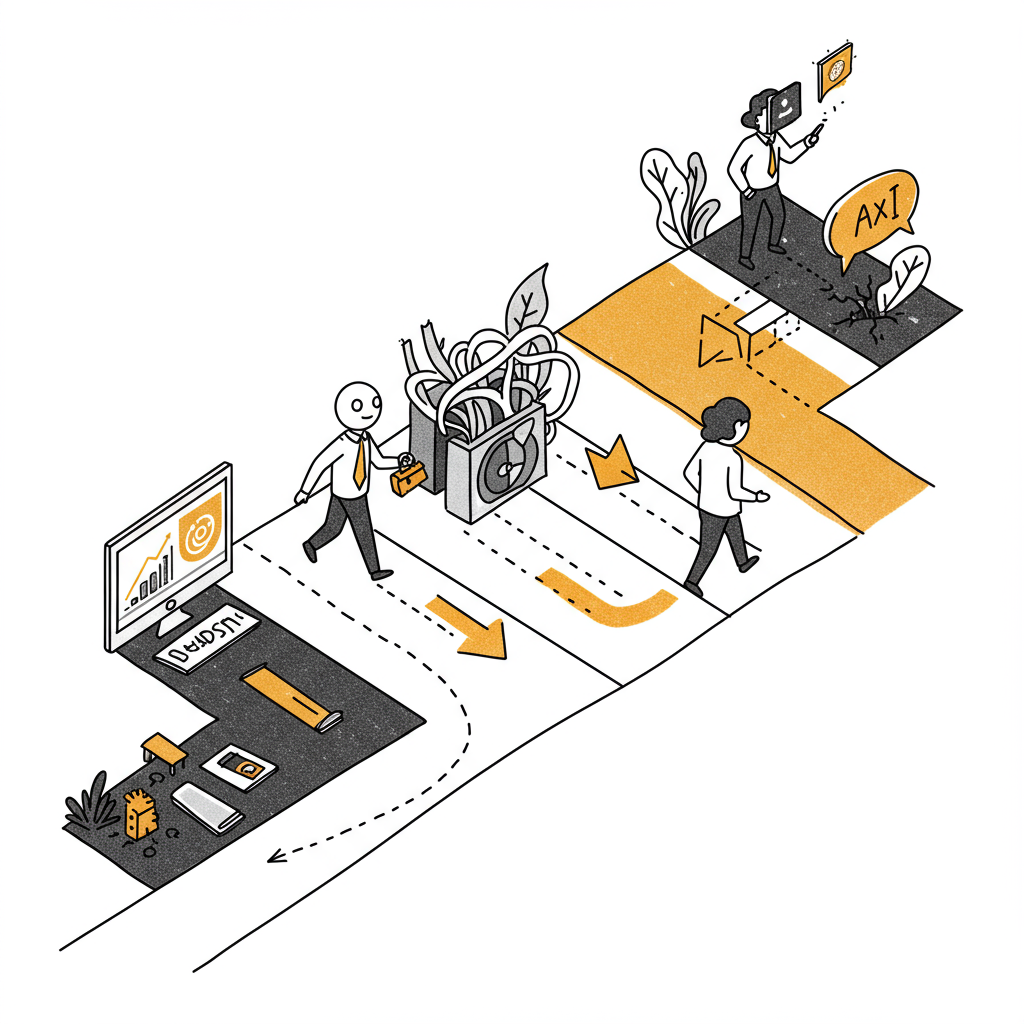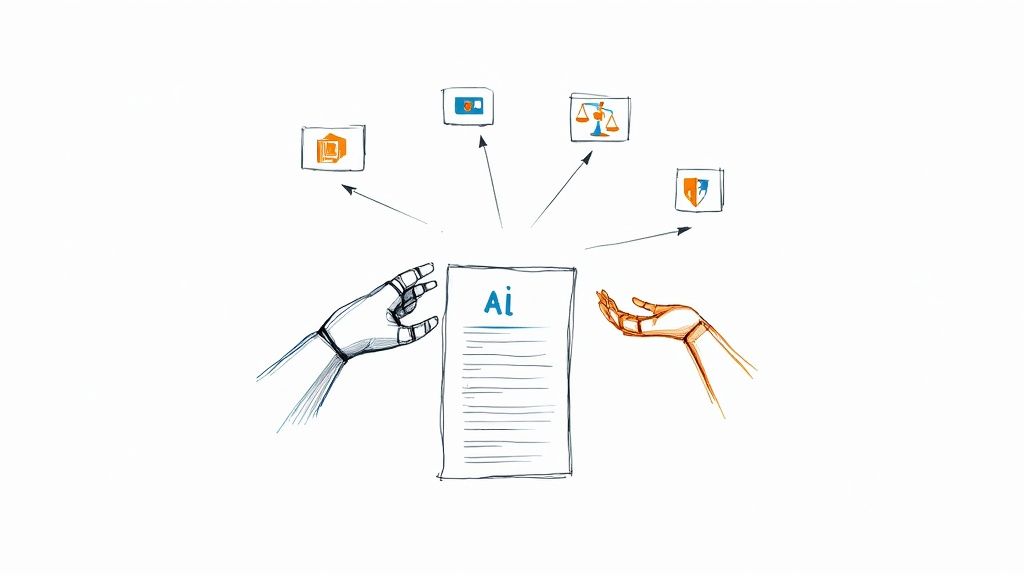Your Guide to Generative AI Consulting Services
Unlock growth with generative AI consulting services. Learn how to build a winning AI strategy, find the right partner, and drive real business transformation.

Generative AI consulting services offer expert guidance to help businesses figure out how to use and scale artificial intelligence that creates new things—like text, images, or even software code. These consultants act as a strategic partner, closing the gap between the promise of AI and its real-world impact on your bottom line.
Why Generative AI Is No Longer Optional
Think about trying to run a business today without the internet. It sounds impossible, right? In the very near future, trying to operate without generative AI will feel just as restrictive.
This isn't just another tech trend. It's a fundamental shift in how work gets done, much like the printing press opened up access to information for everyone. It gives your teams the ability to generate everything from functional software code to brilliant marketing campaigns at a speed and scale that was once unimaginable.
But just having access to a powerful tool isn't enough. To get real value from it, you need a smart plan, the right technical skills, and a clear idea of where it can make the biggest difference. This is exactly where generative AI consulting services come in. They serve as the architects for your company's AI-driven future, helping you draw up a solid blueprint instead of building on shaky ground.
What Generative AI Consultants Deliver
A consultant’s job is to translate the complex, technical world of AI into tangible business results. Below is a quick summary of what they bring to the table and the direct outcomes you can expect.
Service Area | Business Outcome |
|---|---|
Strategy & Roadmapping | A clear plan connecting AI projects directly to your most important business goals. |
Use Case Identification | Pinpointing the specific, high-impact opportunities where AI will deliver the best ROI. |
Technology Selection | Choosing the right AI models and platforms that fit your unique needs and budget. |
Implementation & Integration | Building and connecting AI solutions smoothly into your existing workflows and systems. |
Team Training & Enablement | Equipping your employees with the skills they need to use AI tools effectively and safely. |
Ultimately, this partnership is built on a collaborative process of AI co creation, where your deep business knowledge and their technical expertise come together to build solutions that actually work.
Your Guide to a Smart AI Rollout

The main goal is to move past the hype and start building real applications. A solid AI strategy consulting process is the first step. It typically involves:
Connecting AI to Business Goals: Figuring out which of your operational headaches or growth opportunities are the best fit for an AI solution.
Checking Technical Readiness: Evaluating whether your current data, systems, and infrastructure can handle what you want to achieve with AI.
Prioritizing for Quick Wins: Focusing on the projects that will deliver the most value and return on investment first.
By framing the adoption process this way, companies can skip the expensive phase of trial-and-error. Instead, you get a clear, step-by-step roadmap for integrating AI, which is absolutely critical for long-term success.
Think of Them as Your AI Architect
If building an AI-powered company is like constructing a skyscraper, then a generative AI consultant is your lead architect. They don't just show up with a toolbox; they work with you to design the entire building from the ground up.
The process starts with a strong foundation—your AI strategy framework. From there, they help you pick the right "materials," like specific AI models and platforms. Then, they draw up the blueprints for each "floor," which might represent different business functions like marketing, operations, or customer service.
They make sure every part works together seamlessly, preventing the digital equivalent of a building collapse down the road. The explosive market growth only adds to the urgency of getting this right.
The global generative AI market was valued at USD 25.86 billion in 2024 and is expected to soar to over USD 1 trillion by 2034, according to research from Precedence Research. This incredible expansion sends a clear signal to business leaders everywhere: the time to start building your AI foundation is now.
Why Going It Alone With AI Is a Costly Mistake
Trying to launch a generative AI initiative on your own is a bit like trying to navigate open ocean without a compass. You might have a destination in mind, but the journey is fraught with hidden currents and unexpected storms that can easily throw you off course. A promising investment can quickly turn into a very expensive lesson.
The simple truth is that the talent, tools, and strategies you need to succeed are highly specialized and, frankly, in short supply.
The first wall most companies hit is the severe talent shortage. Finding people with real, hands-on experience in AI model fine-tuning, complex data pipelines, and sophisticated prompt engineering is both incredibly hard and expensive. Many businesses burn through months and a hefty budget trying to assemble a team, all while their competition is already launching new features with the help of outside experts.
But the risks go far beyond staffing. Making a wrong turn on which AI model to use, botching an integration, or failing to lock down your data can lead to blown budgets, stalled projects, and serious security holes. These aren't just technical blunders; they hit your bottom line and can do lasting damage to your company's reputation.
The Breakneck Pace of AI's Evolution
Generative AI isn't a technology you can just "set and forget." It feels like the entire field reinvents itself every few months. New models drop, new techniques are published, and best practices change at a speed that's dizzying for even the most dedicated teams.
For an internal team juggling other responsibilities, just keeping up is a full-time job. This creates some serious blind spots:
Building on outdated tech: What was state-of-the-art six months ago might be a dinosaur today.
Missing game-changing opportunities: Without a constant eye on the market, you could easily miss a new model or tool that gives your competitors a massive edge.
Ignoring new risks: As the technology evolves, so do the security and ethical challenges that come with it.
This is where generative AI consulting services really earn their keep. Their entire business revolves around staying on top of this relentless churn. They're constantly testing new tools, vetting emerging models, and figuring out what actually works in the real world—so you don't have to.
Get to Real Results, Faster
Maybe the most powerful argument for bringing in a consultant is speed. Why spend a year on trial-and-error when you could see meaningful results in a few months, or even weeks? As we explored in our AI adoption guide, getting to value quickly is a make-or-break factor in today's market.
Consultants don't start from scratch. They arrive with a whole toolkit of proven methods and frameworks, all of which have been battle-tested across dozens of client projects. They know what works, what doesn't, and where the common pitfalls are.
When you hire a team with a proven track record, you're essentially buying your way past the painful, expensive learning curve. You get instant access to skills and insights that would take you years to build from the ground up.
This dramatically shrinks the time it takes to see a real return on your AI investment. Instead of guessing where to start, a consultant helps you pinpoint the highest-impact use cases first. This laser focus is a cornerstone of good AI strategy consulting, making sure every dollar you invest is aimed at a clear business goal.
You can get from a whiteboard idea to a working proof-of-concept faster than you ever could alone. This lets you quickly validate your approach, build momentum inside your company, and invest confidently in the solutions that are proven to deliver real value. To get a sense of the expertise that drives this, you can meet our expert team.
The Core Services That Fuel Real Results
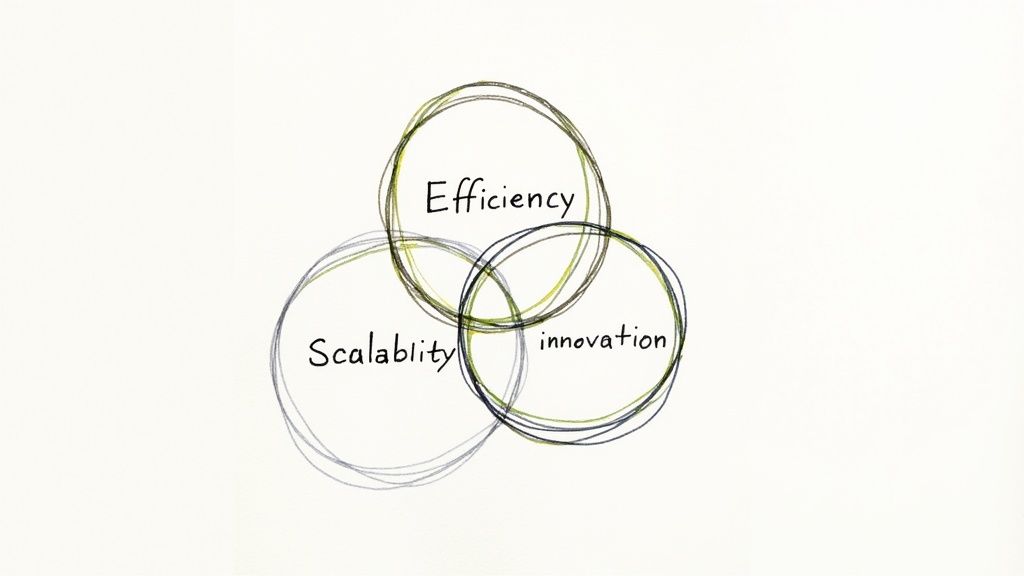
So, what does a generative AI consultant actually do? It’s more than just talking strategy. Their work is a hands-on process that breaks down into clear, value-focused services. The goal is simple: to guide your business from curiosity to concrete outcomes and make this powerful technology genuinely accessible.
This whole journey is built on a philosophy of co-creation. Consultants work with your team, not just for them. They bring the technical expertise, you bring the deep industry knowledge. When you combine the two, you get solutions that are practical, relevant, and designed to solve your specific challenges.
There's a reason this field is booming. The generative AI services market, which includes both the tech platforms and the experts who help you use them, was already valued at $5.125 billion in 2023. Projections show it skyrocketing to $43.8 billion by 2030. This growth is driven by businesses in every sector—from healthcare to finance—all looking to automate work and find new efficiencies. You can dig into the numbers in this report on generative AI services from Valuates Reports.
1. AI Strategy and Use Case Prioritization
Everything starts with a solid plan. Without a clear strategy, any money you spend on AI is just a shot in the dark. This is where AI strategy consulting comes in, and it always begins by answering one crucial question: "Where will generative AI create the most value for our business?"
A good consultant facilitates a deep-dive discovery process. They help you map out your biggest operational headaches and your most promising growth opportunities. From there, they pinpoint exactly where this technology can make the biggest difference. It’s not about chasing shiny objects; it's about surgical precision.
A huge part of this is use case prioritization. You might have dozens of ideas, but an expert partner helps you sift through them to find the one or two initiatives that promise the highest return with the lowest risk.
Scenario: A regional logistics company is bleeding money from high fuel costs and delivery delays.
Consulting Action: The consultant analyzes their operations and identifies AI-powered route optimization as the most impactful place to start.
Outcome: They decide to prioritize this single project over others, like building an internal chatbot, because it directly tackles a multi-million-dollar problem.
2. Proof-of-Concept Development
Once you’ve picked a high-impact use case, you need to prove it can work. This is where a Proof-of-Concept (PoC) comes in. Think of it as a small-scale, functional prototype designed to validate both the technical feasibility and the business value of an AI idea before you commit to a major investment.
A PoC is essentially a low-risk experiment. It answers the question, "Can we actually do this, and will it give us the results we're hoping for?" without the cost and complexity of a full-scale deployment.
Consultants manage this entire process for you. They’ll select the right AI models, prepare the necessary data, and build and test the prototype. Most importantly, they define clear success metrics from the start, so you know exactly what a "win" looks like. This controlled approach builds confidence and gets everyone on board.
3. Full-Scale Implementation and Integration
With a successful PoC confirming you're on the right track, it's time to build the real thing. This phase is all about developing a robust, production-ready AI application and weaving it seamlessly into your existing systems and workflows. It’s a complex job that demands serious technical skill.
This service covers everything from designing the system architecture and writing the code to rigorous testing and helping your team adapt to the new tool. The goal isn't just to deliver a powerful piece of tech, but one that is reliable, secure, and easy for your staff to use every day. To get a better sense of what's involved, you can learn more about our implementation support process.
Ultimately, this is the step that turns a promising AI strategy into a tangible business asset—one that drives daily operations and delivers real, lasting value.
Building Your AI Strategy From the Ground Up
A powerful generative AI initiative isn't something you just buy off a shelf. Think of it less like a tool and more like a core business capability you have to build from the inside out. Real success hinges on the blueprint you follow, not just the technology you choose. This is where an experienced generative AI consultant proves invaluable—they act as the architects, making sure your foundation is rock-solid before the first brick is laid.
This isn't a black-box transaction; it's a deeply collaborative journey. It all starts with a discovery phase to ensure any potential AI project is perfectly aligned with your most important business goals. You wouldn't build a factory without knowing what you're going to make inside, right? The same logic applies here. The entire point is to move from abstract ideas to a concrete, actionable plan.
This visual breaks down the straightforward, three-step process consultants typically use to turn a strategic vision into a working solution.
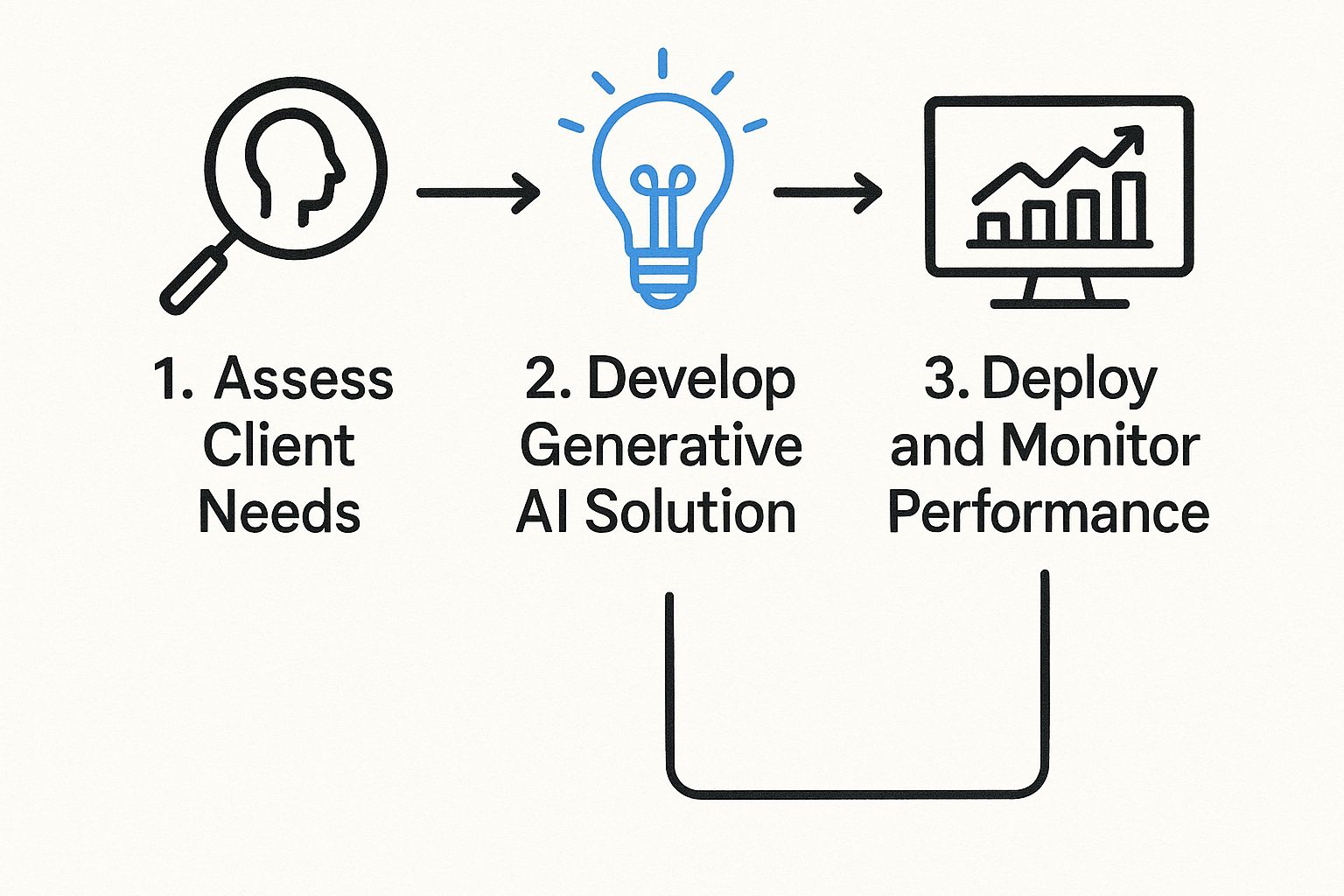
As the infographic shows, it’s a logical flow: first understanding your unique needs with tools like our AI Strategy consulting tool, then designing and deploying a custom AI solution, and finally, monitoring it to ensure it keeps delivering results.
The Discovery and Feasibility Phase
The very first step is always about asking the right questions. A good consulting partner will sit down with your leadership to get to the heart of your biggest challenges and most ambitious goals. Are you trying to slash operational costs? Speed up product development? Or maybe create a customer experience that people rave about? The answers to these questions will guide everything that follows.
From there, the focus narrows to two critical areas:
Technical Feasibility: Can this actually be done? This is a reality check. It involves looking at your current tech stack, data infrastructure, and available resources to make sure your ambition is matched by your capabilities.
Data Readiness: Generative AI runs on data. A data readiness audit is essential to evaluate the quality, quantity, and accessibility of your data. It answers the crucial question: is your data good enough to train or fine-tune the AI models you’ll need?
This initial homework is what keeps you from pouring time and money into projects that are doomed from the start.
Translating Needs Into Technical Blueprints
One of the most common reasons tech projects fail is the gap between what the business wants and what the technology team builds. An expert consultant is a master at bridging this communication divide.
They help translate a high-level business goal into precise technical specifications that engineers can actually work with. This is where ambiguity dies. For example, a vague goal like "improve customer support efficiency" gets translated into a clear technical requirement: "Develop an internal AI agent trained on our knowledge base to provide instant, accurate answers to the top 50 support queries."
A strong strategy isn’t just a document; it’s a shared understanding across your entire organization. It makes sure that business leaders, IT teams, and developers are all speaking the same language and working toward the same measurable outcome.
Creating a Phased Implementation Roadmap
Finally, all this work comes together in a phased implementation roadmap. You can't boil the ocean, and you can't do everything at once. A smart roadmap prioritizes projects based on their potential impact and complexity, often focusing on "quick wins" to build momentum and prove the value of AI early on. For a deeper dive into how this is structured, you can explore our guide on creating a foundational AI strategy.
This plan gives you clear milestones, realistic timelines, and budget estimates for each phase. It transforms what might seem like a massive, daunting initiative into a series of manageable, achievable steps. It’s this structured, methodical approach that turns a bold vision into a tangible reality.
Generative AI Use Cases Driving Real Results
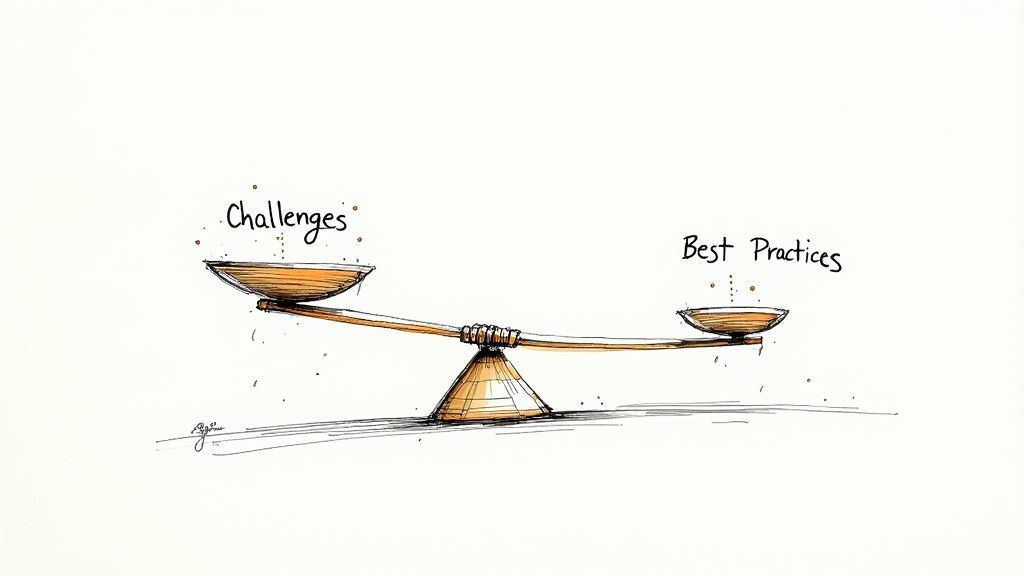
Strategy is one thing, but to truly grasp what generative AI can do, you need to see it in action. The real worth of generative AI consulting services isn’t found in frameworks or roadmaps—it’s measured by the concrete results they deliver. This is where AI stops being a buzzword and starts solving actual problems, creating new efficiencies, and unlocking opportunities that simply weren’t possible before.
The rush for these practical applications is what’s igniting the market. The global AI consulting services market is expected to balloon from USD 11.07 billion in 2025 to a staggering USD 90.99 billion by 2035. That's not just abstract growth; it's a clear signal that businesses are investing serious money to get tangible outcomes. You can dig into the numbers yourself in the full market report from Future Market Insights.
From Healthcare to Manufacturing
One of the most exciting things about generative AI is its incredible versatility. A good consultant doesn't just know the tech; they know how to spot the perfect place to apply it for maximum impact, turning a nagging operational headache into a real competitive edge.
Let's look at some real-world scenarios:
Healthcare: Imagine a hospital network wrestling with physician burnout, largely driven by the crushing weight of administrative paperwork. An AI tool is built to instantly summarize sprawling patient histories, highlighting key diagnoses, medications, and recent labs. Doctors now get a clear snapshot in seconds, freeing them up to do what they do best: care for patients.
Media and Marketing: A media company has a brilliant idea: personalized video ads for thousands of individual customers. The problem? They could never produce that many videos manually. Using generative AI, they automate the whole process, dynamically inserting customer names, specific product images, and tailored calls-to-action into a single video template. The result? A 30% jump in campaign engagement.
Manufacturing: An automotive manufacturer needs a new component that's both lighter and stronger. Instead of the slow, iterative process of traditional design, they use generative AI. The system generates hundreds of viable designs that meet their exact performance specs. Engineers simply review the options and pick the best one, slashing weeks off the development timeline.
The Problem-Solution-Result Framework
Notice a pattern here? Each of these examples follows a simple but powerful formula that’s central to effective AI consulting. It’s a method that ensures technology is always anchored to a genuine business need.
The core process is straightforward: identify a specific business problem, design a targeted AI-driven solution, and then measure the concrete results. This simple approach is what elevates generative AI from an interesting experiment to an essential tool for driving the business forward.
This relentless focus on measurable outcomes is what separates a successful AI project from an expensive science fair project. It’s not about building cool tech for its own sake. It's about building something that works and delivers a clear return. This is where the magic of AI co creation between a business and its consulting partner really shines, blending deep industry knowledge with technical expertise.
If you’re looking for more inspiration, you can explore a full library of real-world use cases to see how other companies are finding success. The stories from these projects can spark incredible ideas for your own organization. It's exactly this kind of practical, results-driven expertise that our expert team brings to the table.
How to Choose the Right AI Consulting Partner
Picking a partner for your AI journey is one of the most critical decisions you'll make. This isn't just about hiring another vendor; it’s about finding a guide who can help you sidestep costly mistakes and get to real results, faster. The right choice can genuinely be the difference between a breakthrough initiative and an expensive science project.
Don't take this decision lightly. A great partner brings far more to the table than just technical chops. They should have a well-honed process, deep industry knowledge, and a real stake in your success. To get this right, you need a solid checklist of what to look for and, just as important, what red flags to avoid. The goal is to find a team that feels like a natural extension of your own.
The Anatomy of a Great AI Partner
Let's be honest: not all generative AI consulting services are the same. A top-tier partner will stand out across several key areas. They should be able to clearly explain their value and, more importantly, show you how they operate, not just talk about it.
Here’s what your evaluation checklist should cover:
Deep Technical Expertise: Can they move past the buzzwords and get into the weeds? A strong partner needs proven skills with various AI models, data engineering, and the messy reality of plugging AI into existing enterprise systems. They have to understand the nuts and bolts.
Proven Industry Experience: Have they walked in your shoes before? A consultant who gets the specific challenges and opportunities in your sector—whether it's finance, healthcare, or retail—will build solutions that actually fit. This is where you see the value of their work on real-world use cases.
A Transparent and Collaborative Model: What does working with them actually feel like? Look for a partner who prioritizes AI co creation and operates with total transparency. It should feel like a collaborative workshop, not a one-sided sales pitch.
A Commitment to Ethical AI: Any responsible partner will have a clear framework for handling the ethical side of AI. This includes everything from data privacy and security to actively working to reduce bias in their models. This isn’t just a nice-to-have; it’s crucial for protecting your business and your customers.
A partner’s value is ultimately measured by their ability to translate complex technology into tangible business outcomes. If they can’t connect their services directly to your bottom line, they aren’t the right fit. This philosophy is central to effective AI strategy consulting.
Critical Red Flags to Watch For
Knowing what to look for is only half the battle; you also have to know what to avoid. Certain warning signs can signal a partner who is more interested in closing a deal than in building a long-term success story with you.
Be cautious of consultants who:
Offer One-Size-Fits-All Solutions: If their pitch sounds like it could be for any company, it's a bad sign. Your business context is unique, and your AI strategy needs to reflect that.
Guarantee Unrealistic Outcomes: Any firm promising overnight success or guaranteed results is selling a fantasy. Real AI projects involve careful planning, experimentation, and refinement.
Lack a Clear Methodology: If they can't walk you through their process—from discovery and AI requirements analysis to implementation and beyond—it’s a huge red flag. A solid plan is everything.
Choosing the right partner sets the tone for your entire AI initiative. We see these principles as non-negotiable, and they're the foundation of how we work. To see the difference that deep expertise and a truly collaborative spirit can make, we invite you to meet our expert team.
Answering Your Key Questions About AI Consulting
Alright, so you see the potential of generative AI, but you still have some practical questions. That's completely normal. Most leaders I talk to are in the same boat. They want to know what this kind of partnership actually looks like on a day-to-day basis and what to expect.
Let's cut through the noise and tackle the most common questions head-on. My goal here is to give you the straight answers you need to feel confident about your next steps.
What Does a Typical Engagement Look Like?
Think of a consulting engagement as a structured partnership, not a vague, open-ended project. It almost always kicks off with a discovery phase. This is where we roll up our sleeves and sit down with your team. We need to get a real feel for your business—your goals, your frustrations, and the tech you're already working with. Getting this right from the start is absolutely critical.
Once we're all on the same page, we move into strategy. This is where the fun begins. We'll pinpoint the most promising, high-impact opportunities for AI and map out a clear plan. Often, the best next step is a Proof-of-Concept (PoC). It's a smart way to test an idea on a small scale, prove it works, and build momentum before you commit to a major rollout.
How Do You Protect Our Company's Sensitive Data?
This is a big one, and it should be. Data security is non-negotiable. Any consultant worth their salt will make this their absolute top priority. Protecting your data isn't a single action; it's a multi-layered defense that should be a core part of your vetting process.
Here’s what you should expect as standard practice:
Ironclad NDAs: A solid non-disclosure agreement is the bare minimum. It's the legal foundation that contractually binds the consulting firm to strict confidentiality.
Secure, Isolated Environments: Your data should never just be floating around. Consultants must use secure, sandboxed environments for all development work to prevent any risk of leaks or unauthorized access.
Data Anonymization: Whenever feasible, sensitive information or personally identifiable information (PII) is masked, anonymized, or replaced with synthetic data during development and testing.
These protocols are in place to ensure your trade secrets and customer data are locked down from start to finish.
What Kind of ROI Can We Realistically Expect?
The return on a generative AI project can be massive, but it's not always as simple as cutting a single line item on a budget. The value often comes from several places at once.
For example, a new AI tool for your marketing team could create content faster, directly impacting reduced labor costs. An AI chatbot handling customer queries might boost customer satisfaction scores and keep them from jumping to a competitor. In manufacturing, a generative design tool could slash product development cycles from months to weeks, giving you a huge first-mover advantage. A good consultant will help you identify these specific metrics upfront and track them relentlessly.
How Much Do Generative AI Consulting Services Cost?
There’s no single price tag. The cost of generative AI consulting really depends on the scope of work, how long the engagement lasts, and the level of expertise you need. A focused strategy workshop might be a few thousand dollars, while a full, end-to-end implementation of a complex AI system could be a six-figure investment.
For a more detailed look at common pricing questions and other specifics, you can find more answers in our comprehensive FAQ section.
It's so important to stop thinking of consulting as a "cost" and start seeing it as an investment. The right partner doesn't just build things; they help you sidestep expensive mistakes and get to a positive return much, much faster.
At the end of the day, any successful AI project comes down to the people behind it. To see the team that can guide you on this journey, meet our expert team.
Ready to move beyond questions and start building your AI strategy? At Ekipa, we help companies rapidly uncover and execute AI transformation opportunities. Get your tailored AI strategy in hours, not months.

